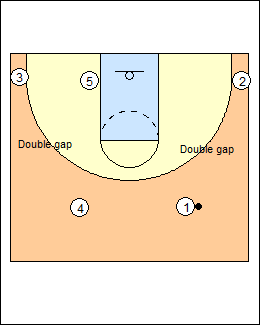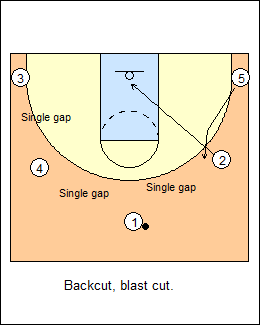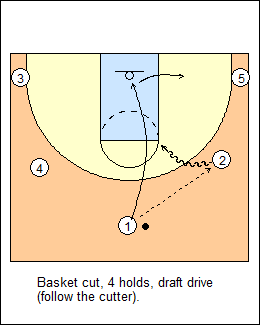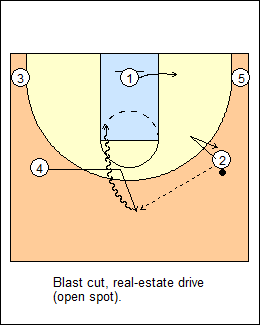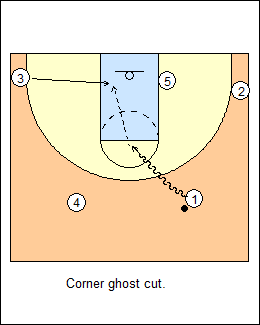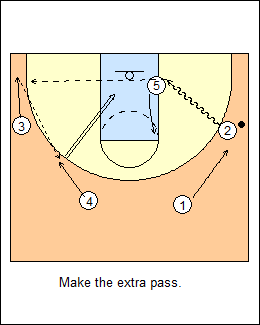Coaches Handbook This handbook provides an overview of key basketball fundamentals, links to drills in each technical and tactical skill area, and a teaching process. Also see See A basketball coach is a planner, leader, motivator, role model, communicator, and teacher of basketball, athletic, and life skills. A good coach is organized, encouraging, develops skills in phases (e.g. a "TLC" approach of teaching, learning, competing), and makes basketball fun and rewarding. See
The Canada Basketball Athlete Development Model (ADM) provides a framework for coaches to use in developing players, and uses long-term athlete development (LTAD) as its guide. The ADM pyramid has four "faces" (components) - fitness, basketball skills, mental skills, and life skills. Basketball skills are broken into four sections:
See SNYB - Athlete development pyramid. Formulate your coaching philosophy, e.g. do you favour a fast break or controlled attack, fullcourt or halfcourt defence, man-to-man or zone defence, good defensive transition or offensive rebounding. Combine that with team player strengths to develop a master plan of team tactics (systems) to be used over the season (fit your offence and defence to your players), see an example Team playbook. From this, prepare a training plan using a pyramid with physical development as the base layer, then fundamental, technical, tactical and mental development. Winning teams play hard (work and compete), play smart and play together. Players are coachable and unselfish, e.g. share the ball, create spacing, know their role, and help on defence. Team is sacrifice.
Early on, focus on physical abilities (e.g. stamina, speed, agility), basic fundamental and technical skills, and basic tactics such as the primary fast break and man-to-man defence. As the season progresses, shift the emphasis to advanced skills, decision-making, and team tactics such as offensive systems and zone defences. Focus on refinement late in the season, resist the urge to put in new concepts. It's not what you run but how you run it, keep it simple, go back and work on fundamentals and execution. See
Practice progressions should flow from the season plan (master and training plans). Show the whole picture, break it into parts, put it back together. Good coaches break their systems down into progressive, teachable steps that challenge players without frustrating them. You coach people, and should understand how they learn. Each practice should have an introduction (outline the emphasis), warm-up, main part, cool-down, and de-brief. Teach new concepts earlier in practice. Run development (teaching) drills and competitive drills (keep score). Coaching is about making players better, so always work on fundamentals, e.g. dribbling, finishing, and especially shooting (alternates and 5ball are practice staples, and use shooting as transition between drills, e.g. foul shots, 20-30 makes). Players forget what they hear, remember what they see (demonstrations), and understand what they do, so most of practice should be spent doing. Practice must be fun. Drills should be short, e.g. 2 minutes for fullcourt passing, 5 minutes for technical (individual) drills, 10 minutes for team tactical drills. Have points of emphasis, pay attention to detail but coach on the fly, stop a drill only to make a point to everyone, if a drill is going badly, move on. Have variety (new drills), alternate hard and easier drills. Use a "games approach" to transfer skills from practices to games (see Basketball Immersion - Games approach),
Most if not all practices should cover fast break, offence, defence, and transition (including converting to defence), with halfcourt and fullcourt scrimmage. See practice plans, tips and ideas from Coach Mac, Steve Nash, Hubie Brown, Ray Lokar, Bob Hurley, Dave Smart (and the Index for their drills), e.g.
It's not what you teach but what you emphasize, and emphasis comes from practice reps. See Go-To Drills for coaches who want some top-shelf options but not a full menu of choices. Also see Blog posts - Drills, Scrimmages. The Canada Basketball Daily Practice Plan has the following parts:
See Canada Basketball Technical Manual, also Youth Practice Structure (up to U12) and Practice Structure (U13 and up). Key physical skills are stamina, speed, agility, and strength (see NBA combine). Off-season development is a must for serious players, especially the aerobic base. See At-Home Training for vertical jump and other conditioning drills. With limited practice time, much basketball conditioning can be done with a ball, e.g., passing, fast break, dribbling, 1 on 1. Defensive footwork drills combine conditioning with skill development, e.g., lane slides, slide and run, fullcourt zig-zag, X closeouts, as do quick backboard tips or rebounds (see Tipping, 5star quick bounce). Supplement with agility drills, e.g. Baller Boot Camp agility. Sprints (anaerobic training) can be used, e.g. winners of a drill run one up-and-back, losers do two. Good footwork with and without the ball is the foundation of good basketball. Players must be able to change speed, change direction (v-cut, spin), stop quickly (1-2 and jump stop), and pivot (front and reverse, either foot), in an athletic stance (ready position). To get open, use a v-cut, L-cut, blast cut, face cut, backcut, spin off, or step over (lockdown). Catch the ball with a hop pivot (jump stop), inside-foot front pivot (cheat step option), inside-foot reverse pivot (Paul Pierce), outside-foot reverse pivot (sweep), or permanent pivot foot. Square up into triple threat, ball on hip, read the defence (e.g. attack the top foot if it is splitting you), pivot to create space (space pivot), attack with a blast or crossover step, counters (fakes) are jab step, shot fake, sweep (low), rip (high), pass fake. Do triple-threat layups, then one-dribble layups, and one-dribble pull-ups. If a player is cut off on a drive, change direction, pick it up (shoot), back it up (pullback dribble), or give it up (pass), sealing with a reverse or step-thru pivot on the inside foot, or separating with a step back or front pivot on the outside foot. See Blog posts - Shooting Footwork, Jab Steps, Body Jab and Shimmy Moves, Skills checklist - Footwork. Dribbling effectively with either hand is essential in getting the ball in position to score. Players need to be able to advance the ball, shift speeds, change direction, protect the ball, and escape pressure, but not over-dribble. For a learning progression, do stationary ballhandling and fullcourt dribbling (with one ball then two), cone dribbling, and attack the basket with primary and secondary moves (see Dribbling series). Primary moves include inside-out, dribble-jabs, and hesitations (stutter, heavy foot, skip, glide or lift). Secondary moves include regular, push and Iverson crossovers, between the legs, behind the back, reverse and spin dribbles. Protect the ball using a crab or back-down dribble, escape pressure (create space) using a retreat or lateral dribble. When attacking, get into a drop stance (e.g. using a hip swivel), and create space using a stop-separation move, e.g. drag pullback. See Blog Posts (Dribbling & Moves), Skills checklist - Dribbling. The importance of passing can't be over-stated, yet it tends to be under-taught. Players must be able to find open teammates and complete passes off the dribble and out of triple threat, using pass fakes, pivoting, and sweep/rips. Start using a wall, then partner passing, one ball then two, stationary then fullcourt (see Tauer partner, Baker drills, Florida 4-line). Work on essential passes (chest, bounce, push, overhead), add kick, shovel, pocket, hook, behind the back and other advanced passing. If you use two hands to pass, without jumping, you can change your mind. Catching the ball, a player should anticipate a pass (be ready), give a target (show both hands), keep your eyes on the ball (catch with your eyes), meet the pass, catch with soft hands (give with the ball, both hands, or block and tuck a pass to the side), use a jump stop (ball in the air, feet in the air) or a 1-2 stop. See 5star hands. See Skills checklist - Passing & catching. Finishing is scoring at or close to the rim with a layup or dunk. Being able to finish at any angle with either hand is important, e.g. overhand, underhand, sidehand or reverse layup. After regular layups with either hand, the next priority is shooting off two feet in traffic, a power layup from an outside-inside or jump stop. Counters include upfake-shoot, reverse pivot, step across, step thru, and spin away. Reverse layups are a good third priority (with either hand). Other finishing moves include one-hand pickup, pro hop, Euro step, floater, swing step, first step (early layup), spin, and finishing with contact (e.g. pound evasion, veer). Work on finishing from the wings (outside, middle), out top (left, right) and the corners (baseline, also middle). See Blog Posts (Finishing), Skills checklist - Finishing. Shoot with BEEEF principles - balance, eyes, elbow, extension, follow-through. Form shooting is a must, e.g. lying on the floor, at a basket, or with a partner (see Keys to shooting, Tauer form). Skill areas include free throws, catch and shoot (spot-up and on-the-move, including 3s), and shots off the dribble, e.g. in transition, coming off ballscreens, one-dribble pull-ups, stepbacks, fadeaway jumpers, drag pullbacks, freeze pull-ups, and slide 3s. See Blog Posts (Shooting), Skills checklists - Shooting, Footwork. Typical post play is a back-to-the-basket post-up in the low post, with a progression of options:
Post players also play in the high post and short corner, e.g. against zone defence. One hack is to get open where you can score easily without a post move, and stay open by sealing. For example,
See Blog posts - Post play, Getting open as a post, Skills checklist - Post play, Post play - Post moves & shots. Winning the battle of the boards is incredibly important (defence wins games, rebounding wins championships). Although height and jumping ability are advantages, the keys are determination and technique - most rebounding is done below the rim. Defensively, see the shot, assume a miss, get low, move your feet, find your man, hit him (make contact with a forearm), or box out with a step-through (front pivot) and/or reverse pivot, then go get the ball. Use just a reverse pivot close to the basket, and hold the box-out (hit and hold). Offensively, try to get around, make a move, e.g., jab and go opposite, swim move, spin off. See Skills checklist - Rebounding. Good team defence doesn't let other teams do what they want to do, and keeps them from getting good shots. Pressure the ball, keep it out of the paint (no layups or inside-out shots), contest all shots, allow no second shots (get every rebound), and avoid fouling. Key skill areas are defending the ball, away from the ball (gap, deny, help positions), dribble penetration, cutters, screens, in the post, and on post-entry passes (e.g. choke, dig, trap). Stations can be used. Start with on-ball defence - stance (Nash wave), slides (see Duke, DeMatha, slide and run), close-outs (Pack-line, Vegas, Lines), jumping to the ball (Face cuts), contesting passes (Villanova). Work on technique then go live 1-on-1, e.g.,
A good progression is shell breakdowns (e.g. 2 on 2 with coaches as passers), then 4 on 4 shell (see Practice Structure for drills). Also build up from 2 on 2 screening situations (MacKay and Celtics ballscreens, Oakland downscreens), using gap, switch etc. See a 10-week defensive training program (pdf). See Blog posts - Closeouts, Jump to the ball, Ballscreen coverage, Defending off-ball screens, Skills checklist - Defence. Fullcourt pressure can wear down other teams, cause turnovers, and increase pace. Good conditioning is a must (and is also a by-product). Key skill areas include forcing and turning the ball, trapping, run and jump, intercepting a pass, and back-tipping on a break-out dribble. Fast break on misses and makes to get easy baskets, get into offence early in the shot clock, and help wear out the other team.
Inbound quickly on a make, rebound and outlet on a miss (or break-out dribble), sprint to fill the lanes (both wings and to the rim), be able to score at high speed in advantage situations (e.g. 2 on 1, 3 on 2), but even 3 on 3 is an attacking situation because of available space.
The fast break can be "numbered" (each player has a specific role) or unstructured (see Fast Breaks for player-role options).
On a primary break, headman the ball, look for a wing attack (usually baseline), post dive, or skip pass to a shooter and post seal. A rim run collapses the defence, making ball reversal to a shooter easier. On a secondary break, push the ball into the frontcourt, get the ball to the baseline (flatten the defence), reverse the ball (move the defence), try to get it inside (collapse the defence), flow into offence. Optionally the trailer ballscreens if he arrives and nothing has happened yet.
Progressions to build up the fast break in practice:
See Blog post - Fast Break. The fast break is transition from defence to offence, converting is transition from offence to defence. Often much time is spent on halfcourt defence, and not enough on transition defence. Good defensive transition teams usually have one or more safeties who don't offensive rebound when their team shoots, they get back to help defend a fast break (don't give up easy baskets). Other tactics include jamming the defensive rebounder (delaying an outlet pass), and picking up the ball early to slow it down. Being able to match up is important, and defending out-numbered situations, e.g., 2 on 1, 3 on 2. Players enjoy transition drills, e.g. 3 on 2 to 2 on 1. The goal on offence is to get a good shot every trip. Good offensive teams have spacing (spacing is offence, offence is spacing), player movement (cutting), and ball movement (passing, share the ball).
Spacing creates gaps, cutting creates bigger gaps. 4-out 1-in spacing allows double gaps for dribble penetration and blast cuts to the ball. 5-out spacing is single gaps to start but allows for backcuts, the rim is vacated.
A basket cut or backcut creates a double gap for a drive behind the cutter or a blast (fill) cut; a blast cut can open up an immediate drive or another blast cut. Delay a fill cut to maintain a double gap for dribble penetration.
Put pressure on the front of the rim, get the ball into the paint with a pass, drive or post touch. A basket cut or backcut is a scoring opportunity, then exit cut but first read what's going on (e.g. react to a drive or shot). Other actions to create double gaps include screens, dribble-ats and handbacks. In general don't pass and stand, especially on a stationary pass.
On dribble penetration,
Look to change sides of the floor (ball reversal) or get the ball inside before a shot is taken, unless it's a green-light shooter. Each action flows into another, players make reads and have options (they may be either/or decisions to start).
Attack mismatches, create opportunities for the best match-ups to go 1-on-1, it's players that are hard to guard, not plays. Get closeouts on your best players.
Be quick on offence, but don't hurry. The most open you are going to be is when you first catch the ball (Chuck Daly), so think attack on the catch - shoot, drive a hot closeout, or pass.
Create an advantage, then convert an advantage before the defence recovers back to neutral,
Key offensive tactics include
See Offences - 5-out youth motion, MacKay single-double gaps, Tactics - Creating Gaps, Teaching 4-out motion, Blog posts - Conceptual Offence, Blast Cuts. Keys to zone attack are
See Zone offences - Duke, Hurley, Bill Self, Dave Odom 1-3-1, Principles, sets and options. If your team can't break fullcourt (or halfcourt) pressure, it makes for a long, frustrating season. A good press offence provides for ball reversal, secondary options if the point guard is denied, and court spacing when a ballhandler is under pressure - three short pass options, one long option (see Press Breaks). Individually, players need to be "ball tough", meeting passes, strong pivot, sweep and rip, fake and pass opposite.
For a full warm-up, add a post-guard split (see a pre-game routine), a shell drill (e.g. swing the ball, stop a baseline drive, see Oakland closeout), or Serbia 3 on 3. With U10 teams I use
|

